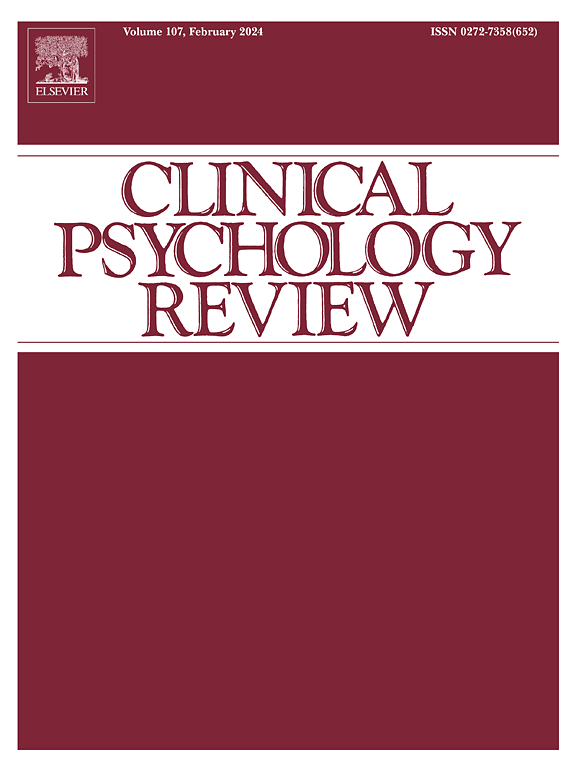在心理健康研究中使用经验抽样方法测量快感缺乏症及其相关因素:系统综述
IF 12.2
1区 心理学
Q1 PSYCHOLOGY, CLINICAL
引用次数: 0
摘要
快感缺乏症是指在日常生活中缺乏或失去快乐。这是第一个系统回顾调查快感缺乏症在心理健康研究的重点是经验抽样方法(ESM)。本综述旨在确定在ESM研究中如何概念化和测量快感缺乏症,在日常生活中是如何经历的,以及在已发表文献中报告的质量。为了对快感缺乏症有一个全面的了解,我们还研究了通过ESM评估的快感缺乏症的时不变测量与其他情感、认知和行为过程之间的联系。我们检索了PsychARTICLES、MEDLINE、Psychology Databases、EMBASE、Web of Science Core Collection和Europe PMC(最后检索日期为2025年1月6日)。我们确定了113篇相关文章。快感缺乏症通常被定义为快乐、享受或喜好的减少,强调完成性体验而不是预期性体验。预期性和完满性快感缺乏症存在于经历不同心理健康状况或症状的样本中(人与人之间),并且在日常环境和时间(人与人之间)有所不同。与快感缺乏症相关的日常生活因素包括消极情绪增加、积极情绪减少、情绪预测偏差和社会过程。大多数研究探讨了抑郁症或精神障碍中的快感缺乏症,尽管测量方法不同,而且对ESM研究报告质量评估工具的依从性普遍较低。这篇综述表明,在心理健康研究中使用ESM来测量快感缺乏症对于确定日常生活中如何以及何时经历快感缺乏症至关重要。未来的快感缺乏症研究将受益于使用跨诊断视角、标准化和验证的ESM项目、在更短的时间尺度上探索瞬间到瞬间的变化,以及增加方法报告的透明度。本文章由计算机程序翻译,如有差异,请以英文原文为准。
Using the experience sampling methodology to measure anhedonia and its correlates in mental health research: A systematic review
Anhedonia is a lack or loss of pleasure in daily life. This is the first systematic review to investigate anhedonia in mental health research with a focus on experience sampling methodology (ESM). The review aimed to identify how anhedonia is conceptualized and measured in ESM research, how it is experienced during daily life, and the quality of reporting in the published literature. To generate a comprehensive picture of anhedonia, we also examined associations between time-invariant measures of anhedonia and other affective, cognitive, and behavioral processes assessed via ESM. We searched PsychARTICLES, MEDLINE, Psychology Databases, EMBASE, Web of Science Core Collection, and Europe PMC (last search 6th January 2025). We identified 113 relevant articles. Anhedonia was typically conceptualized as diminished pleasure, enjoyment, or liking, with emphasis on consummatory rather than anticipatory experiences. Anticipatory and consummatory anhedonia were present in samples that experienced different mental health conditions or symptoms (between-person) and varied across daily contexts and time (within-person). Daily life correlates of anhedonia included increased negative affect, decreased positive affect, affect prediction biases, and social processes. Most studies explored anhedonia in depression or psychotic disorders, although measurement was heterogeneous, and compliance with a reporting quality assessment tool for ESM studies was generally low. This review demonstrates that using ESM to measure anhedonia in mental health research is critical to identify how and when it is experienced in daily life. Future anhedonia research would benefit from using a transdiagnostic perspective, standardized and validated ESM items, exploration of moment-to-moment changes over shorter time-scales, and increased transparency in methodological reporting.
求助全文
通过发布文献求助,成功后即可免费获取论文全文。
去求助
来源期刊

Clinical Psychology Review
PSYCHOLOGY, CLINICAL-
CiteScore
23.10
自引率
1.60%
发文量
65
期刊介绍:
Clinical Psychology Review serves as a platform for substantial reviews addressing pertinent topics in clinical psychology. Encompassing a spectrum of issues, from psychopathology to behavior therapy, cognition to cognitive therapies, behavioral medicine to community mental health, assessment, and child development, the journal seeks cutting-edge papers that significantly contribute to advancing the science and/or practice of clinical psychology.
While maintaining a primary focus on topics directly related to clinical psychology, the journal occasionally features reviews on psychophysiology, learning therapy, experimental psychopathology, and social psychology, provided they demonstrate a clear connection to research or practice in clinical psychology. Integrative literature reviews and summaries of innovative ongoing clinical research programs find a place within its pages. However, reports on individual research studies and theoretical treatises or clinical guides lacking an empirical base are deemed inappropriate for publication.
 求助内容:
求助内容: 应助结果提醒方式:
应助结果提醒方式:


